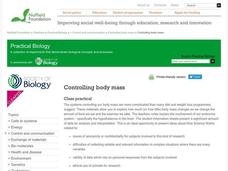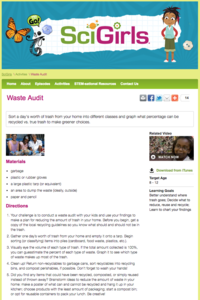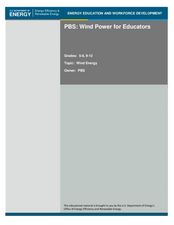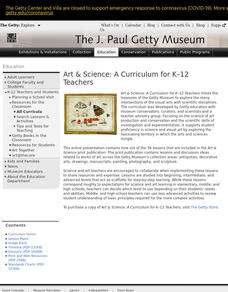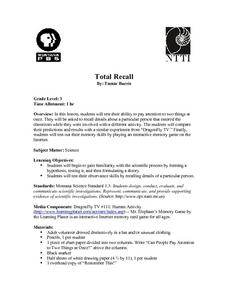It's About Time
Accidents
Did you know that cars weren't designed for passenger safety until the 1960s? The lesson starts with a quick quiz on automobile safety. Then, scholars evaluate three cars for their safety features. This is the third in a set of nine...
Global Oneness Project
The Consciousness of Nature
Scholars voice their opinions about animal consciousness with an article that challenges common ideas about nature. After reading the article, learners engage in a thoughtful discussion before writing out their arguments in a persuasive...
Royal Society of Chemistry
Units of Volume
Did you know in the UK a quart is smaller than in America? This explains why a standard unit of measure is necessary for volume. Young scientists learn the similarities and differences between five different units used to measure volume....
Nuffield Foundation
Controlling Body Mass
Many variables impact your body mass, not just diet and exercise. Scholars collect and study data about body mass to better understand the complexity of a sensitive topic. They learn about leptin deficiency, the hypothalamus, and more.
PBS
Waste Audit
Does everything in the trash can belong there? Conduct a waste audit with your class by collecting a day's worth of garbage, separating it into recyclables, non-recyclables, or food waste, and properly distributing what they find into...
Bonneville
Solar Powered Calculator
The perfect place to do one's math homework? Outside, of course. The third of seven lessons in the Understanding Science and Engineering unit focuses on solar energy. Learners investigate solar-powered calculators and discover how solar...
Curated OER
Wind Power for Educators
Students explore wind power as a renewable resource. In this wind power instructional activity students build models of wind turbines and experiment with different changes to see if it increases efficiency.
Curated OER
To Clear or Not To Clear, That Is the Question
Pupils plan how to manage a fictional timber resource. In this earth science lesson plan, young scholars research the options and repercussions of logging a forested plot of land. Pupils consider the implications of logging to the...
Curated OER
Preservation Through Education: Activities and Programs
Students participate in different activities to help them discover the need for preservation. They pretend they are underwater archaeologists and create a sketch of a mock shipwreck in their classroom. They label the parts of the ship as...
Curated OER
Capturing Light: The Science of Photography
Students create their own cameras to understand how artists use light to capture an image in a photograph. In this light lesson plan, students use tape, wax paper, rubber bands, and more to create their cameras.
Curated OER
Discover the science of archaeology
Students research archaeology. In this archaeology lesson, students conduct research about archaeology and one ancient culture. Students write a magazine article about an archaeological dig.
Curated OER
#2 Pencil Innovations: Inventions, Science
Ask your class to consider a #2 Pencil to show how inventive thinking can be stimulated by making innovations to an everyday object. There is also an interesting extension included that refers to a book about the history of the pencil....
Curated OER
Brown v. Board
High schoolers investigate Brown versus Board of Education. They read and discuss a handout, discuss vocabulary terms, and in small groups create a brochure, bookmark, puzzle, and a short skit.
Curated OER
You Got The Whole World In Your Hands: Geology, Earth's Layers, Science
Pupils make a model of the Earth's crust out of foam in order to better explain the make-up of the Earth's layers. They add continents and oceans.
Curated OER
Finding Your Center of Gravity: Science, Math, Measurement, Math
Students use bathroom scales, rulers and boards to explore how to measure their own center of gravity.
Curated OER
Science Inquiry Lesson: Mapping Project
Students explore the methods of creating maps. They create a map of Animas River Park using a compass and measuring tape, develop a single map from the team map sections, and devise another map of the Animas River Park using a GPS unit.
Curated OER
Understanding Science Vocabulary And Categorization
Young scholars explore and examine scientific language and categorization as related to commonly known plants and animals. They hypothesize about a specific plant or animal, how it was scientifically named, what concepts and vocabulary...
Curated OER
Peer Editing
Sudents read and critique three of their fellow classmates' science fiction short stories on three consecutive days for mechanics, short story elements, style, and informational elements.
Curated OER
Cell-ebrations in Science
Students recognize that all living things are made up of cell and that they cannot easily be seen by the naked eye. Students become familiar with the use of microscopes as a tool for investigation.
Curated OER
Science That's Out of This World
Students use iChat AV and an iSight camera to "meet with" a space scientist to ask and answer questions, visit relevant websites, and broaden their understanding of the solar system and space. They videoconference with a sientist and...
Curated OER
Science: Total Recall
Third graders attempt to recall details about a person entering the classroom while they are involved in another activity. They test their skills of observation and memories by playing an interactive memory game.
Curated OER
Science: Leaf Study
First graders go on a leaf-hunting expedition around the schoolyard. They determine from which trees they fell using identification cards. Students read several books about leaves and apply their artistic skills by using the collected...
Curated OER
Life Science: DNA Whodunit?
Students role play an honorary detective to assist in solving a crime committed. They investigate by a bank robbery and interview eyewitnesses using their Crime Investigation Notebook and clues from an eyewitness account from the...
Curated OER
Earth Science: Create a Star Clock!
Students identify and use the starts to tell time just as people had for thousands of years. They identify the stars that appear to rise in the east and set in the west, and that those stars near the North Pole appear to go in circles...
Other popular searches
- Physical Education and Science
- Adaptive Pe Science
- Earth Science Education World
- Pearson Education Science
- Physical Education in Science





